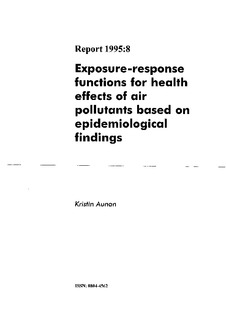Exposure-response functions for health effects of air pollutants based on epidemiological findings
Research report
Permanent lenke
http://hdl.handle.net/11250/192122Utgivelsesdato
1995Metadata
Vis full innførselSamlinger
- CICERO Reports [210]
Sammendrag
Quantitative knowledge about health damage due to air pollution is an important element in analyses of cost-effective abatement strategies, and it is also essential for setting Air Quality Standards. In this context epidemiological studies, in spite of the numerous problems and caveats connected to them, provide a sound basis for exposure-response functions, because they generally involve a random cross section of the population regarding sensitive populations, age and gender, and also regarding personal exposure level relative to the average pollution level. The outdoor concentration levels, upon which epidemiological studies are often based, may be far from the actual exposure, but may probably in most cases serve as a reasonably good indicator of the relative pollution load.
The exposure-response functions in this paper apply to the relation between air pollutant concentrations and relative effect frequencies, and involve the following health effect end-points: Reversible effects: Acute and chronic respiratory symptoms in children and adults; asthma episodes in children and adults; eye irritations; head-ache; and irreversible effects: lung damage in children; excess mortality; lung cancer incidence. The effects are attributed to one indicator component, which in many cases is particles, but for some effects NO2, SO2, O3, or CO. A calculation procedure is suggested which makes it possible to estimate excess annual symptom-days for short-term effects using the annual average concentration.
